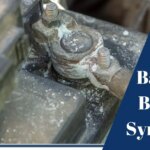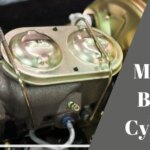You’ve worked very hard to create beautiful ceramic-coated surfaces, but there is always one concern regarding the clay bar. Can you clay bar ceramic coating to prevent contamination? In this blog, you can get the answer to this query and how to maintain your ceramic-coated car’s flawless appearance.
In short, claying invariably hurts the ceramic coating, which cannot be repaired by polishing. Instead, you can use chemical decontamination or an iron remover to maintain the coating.

Table of Contents
What Is a Clay Bar?
Car detailers utilize clay bars, a natural or artificial tool made of a resin mixture and other synthetic components, to remove impurities and pollutants from fiberglass, paint, glass, or metal. In essence, it’s among the best and simplest methods for offering a clean surface.
It is elastic and can be stretched into different shapes, similar to natural clay. This implies that a clay bar can be shaped to match a smooth surface, like the surface of your car. Yet, its elastic nature causes it to automatically seep into any minor irregularities. When used properly, small dirt particles will adhere to the clay, cleaning the painted surface.
The clay bar has several grades. The rougher or harder grades of clay bars are typically employed as a pre-treatment before attempting to remove deeply ingrained material. However, harder clay bars carry a greater danger of scratching your automobile’s paint and necessitate waxing the car after washing to patch any small holes.
Using the clay bar can remove the following:
- Dust and road grit
- Brake sludge
- Metallic flakes
- Acid rain deposits
- Bird droppings, sap, and bug smears
Can You Clay Bar Ceramic Coating?
A clay bar, mitt, or towel should not be used on a car that has a ceramic coating because doing so will weaken the coating.
Because of their abrasive properties, clay bars can clean the paintwork of impurities like tar and tree sap. But it also means that the ceramic coating is abraded. You can perhaps remove it by grinding away at the covering with a clay bar.
Clay is an abrasive substance. Therefore, it can potentially leave swirl and scratch marks. This harms not only the clear coat but also the ceramic coating.
A ceramic coating that has been clayed frequently seems extremely swirling. This is because the clay itself and any pollutants it picks up will damage the coating when brushed against it. In direct sunlight, it might appear very horrifying.
A clay bar should never be used on a ceramic coating unless you wish to remove it fully. You’ll be doing more harm than good if you don’t.
A coated car usually doesn’t need to be clayed
Another reason not to clay an automobile with a ceramic coating is that it is not required.
The fundamental benefit of applying a ceramic coating is that it is extremely hydrophobic, preventing dirty water from adhering to the surface and drying out. This indicates that while the dirt is quickly washed away during the washing process, pollutants have difficulty adhering to it.
This also holds true for other contaminant sources, such as bird droppings and water stains. On a coated car, contamination is often not a problem because of how efficiently the ceramic coating repels it.
However, some pollutants will attach to the coating over time, especially if you’ve had the coating for more than a year. You can check this by:
- Clean and dry the vehicle
- Put your hand inside a sandwich-sized plastic bag, then gently rub the paint with it
- If it feels scratchy or grippy, impurities have attached themselves to the coating
But what if you still want to use clay bars with a ceramic coating on a car?
You can still use a clay bar or synthetic clay on a car with a ceramic coating. To get rid of the hard road film, perform this procedure once or twice a year. It is more aggressive and has a higher possibility of scratching the coating, so keep that in mind.
The Fine Grade Clay Bar should be used since it is gentler and less abrasive than other grades.
A lubricant must be applied before using it to enable the clay bar to slide easily across the surface of the paintwork. In addition to the problems with marring, not utilizing lubrication can also leave tiny, challenging-to-remove clay particles on your car’s paint.
Common Mistakes to Avoid when Treating Clay Bar on Ceramic Coating
If you decide to clay bar your ceramic-coated car, it’s important to handle the process with care and precision. While clay bar treatment can effectively remove contaminants and restore the shine of your ceramic-coated vehicle, there are some common mistakes that you should avoid to ensure optimal results. Here are the key mistakes to steer clear of:
Using excessive pressure
One of the most common mistakes people make during clay bar treatment is applying too much pressure. While it may seem like exerting force will yield better results, it can actually lead to damage.
Excessive pressure can cause the clay bar to dig into the surface and potentially leave scratches or swirl marks on the ceramic coating. It’s important to remember that the clay bar’s purpose is to lift contaminants gently, so apply light to moderate pressure for effective cleaning without causing harm.
Not lubricating the surface adequately
Lubrication is crucial during clay bar treatment as it minimizes friction between the clay bar and the surface. Failing to use enough lubricant can lead to the clay bar dragging across the ceramic coating, increasing the risk of marring or scratching.
To avoid this mistake, generously apply a suitable lubricant, such as a clay lubricant or a diluted car wash solution, to ensure smooth gliding of the clay bar and prevent potential damage.
Using a contaminated clay bar
Using a contaminated clay bar is a major mistake that can compromise the effectiveness of the treatment and even cause damage to the ceramic coating. Over time, clay bars accumulate contaminants such as dirt, debris, and particles from previous uses. If you use a contaminated clay bar, these particles can scratch the surface of the ceramic coating, defeating the purpose of the treatment.
Always inspect the clay bar before each use and discard it if you notice excessive contamination or visible particles embedded in it.
Neglecting to inspect the surface before treatment
Before starting the clay bar treatment, it’s essential to inspect the surface of the ceramic coating thoroughly. Neglecting this step can unintentionally drag abrasive contaminants across the surface, resulting in scratches or swirl marks.
Inspect the surface under proper lighting conditions to identify any visible contaminants or imperfections. If you notice any, addressing them before proceeding with the clay bar treatment is advisable. This may involve using other methods like washing, decontaminating, or spot cleaning to adequately prepare the surface.
How Do I Clean a Ceramic Coating of Contamination?

Tar and iron fallout will likely have contaminated the surface of your car’s ceramic coating if it has been there for more than a year. You can clear this out in this situation by using chemical decontamination.
The most frequent pollutants that stick to and settle on the paintwork are tar and iron fallout. Instead of physical decontamination (claying), you can get rid of them through chemical decontamination.
To eliminate this contamination, wash your car as usual and use tar remover and iron fallout remover sprays. They won’t wear down the ceramic coating nearly as quickly as clay, which is fantastic.
Furthermore, you don’t run the risk of abrading the contamination away like a clay bar does because you aren’t contacting the paintwork.
A treatment every now and then with a PH-neutral iron remover, such as Iron X, will work wonders to keep the contaminations at bay.
Of course, you don’t need to apply tar remover or iron fallout frequently. Serviced every six months is usually sufficient.
How to Maintain a Ceramic Coated Car

Prevention is better than cure. Keeping the car in good condition may prevent many common pollutants from adhering to the ceramic coating. Here are some ways:
1. Wash regularly
Regular cleanings with warm water and mild soap are required for surfaces covered with ceramic. If your car is ceramic coated, you should clean it at least once a month. Use vinegar or lemon juice as an acidic cleaner to help you get rid of tough stains. Avoid using anything abrasive on the coating, such as steel wool or ordinary soap.
2. When cleaning a ceramic-coated surface, use only recommended soaps
Surfaces with a ceramic coating are particularly robust. They need specific maintenance to maintain their beautiful appearance for many years. Here are some cleaning and maintenance suggestions for ceramic-coated surfaces:
- Only use certified soaps. The protective layer on your coating will be stripped away over time by phosphate- or detergent-containing soaps, leaving it looking dull. Use only soap that doesn’t have these components in it.
- Avoid using bleach-based cleansers. If bleach is in contact with your flooring for an extended period of time or at a high concentration, it may permanently stain it.
- Avoid using cleansers with oil bases. Oil-based cleansers will create a greasy layer that draws dust, debris, and other irritants, which over time, will scratch off the topcoat and harm your surface permanently!
3. Polishing chemicals can be used to get rid of the scratch
If a scratch appears, a polishing compound should be used to remove it. Most auto parts stores provide chemicals made expressly for removing scratches from ceramic-coated surfaces. Use a clean cloth to apply the compound, then rub it into the scrape until it vanishes.
4. Wash any bird droppings off
It’s crucial to guard against bird droppings on ceramic-coated surfaces. The finest cleaning solution for these surfaces is warm water mixed with mild soap. After removing the droppings, thoroughly clean the area with warm water and a light detergent. Use a soft-bristled brush or towel to wipe away any bird droppings that may have fallen on the surface.
Check out This Video for How to Clay Ceramic Coated Paint!
Frequently Asked Questions
1. What is the purpose of clay bar treatment?
The purpose of clay bar treatment is to remove embedded contaminants, such as dirt, brake dust, and industrial fallout, from the surface of the ceramic coating, resulting in a smooth and clean finish.
2. Can clay bar treatment remove contaminants from ceramic coating?
Yes, clay bar treatment is effective in removing contaminants from ceramic coatings. The clay bar’s sticky texture helps lift and trap contaminants, leaving the ceramic coating free of impurities.
3. Is clay bar treatment safe for all types of ceramic coatings?
Clay bar treatment is generally safe for most types of ceramic coatings. However, it’s important to refer to the manufacturer’s instructions or consult a professional to ensure compatibility and avoid any potential risks.
4. Can I use a clay bar on a new ceramic coating?
Yes, you can use a clay bar on a new ceramic coating. Even though the ceramic coating provides protection, it can still accumulate surface contaminants over time. Clay bar treatment helps remove these contaminants, restoring the coating’s original shine and ensuring its longevity.
5. Will clay bar remove ceramic coating?
No, clay bar treatment will not remove the ceramic coating itself. It is designed to remove contaminants from the surface of the ceramic coating, but it does not strip away the protective layer.
6. Can I use clay bar treatment on other surfaces besides paint?
Clay bar treatment is primarily intended for use on automotive paint surfaces. While it can be used on certain smooth surfaces like glass or chrome, it is not recommended for use on rough or porous materials such as plastic, rubber, or textured trim.
7. Are there any alternatives to clay bar treatment for ceramic coatings?
Yes, there are alternative methods to clay bar treatment for ceramic coatings. Synthetic clay mitts or clay towels are available, which offer similar contaminant removal capabilities as clay bars but with a different application technique. Some chemical decontamination products can also help dissolve or lift contaminants without physical abrasion.
8. Can I clay bar my vehicle if it has wax or sealant on it?
Clay bar a vehicle is generally not recommended if it has wax or sealant on it. The clay bar may remove or diminish the wax or sealant layer, reducing its protective properties. It’s advisable to clay bar the vehicle first and then apply wax or sealant afterward for optimal results and protection.
Conclusion
While many different forms of contamination can be removed with a clay bar, most people are unaware that claying can harm ceramic surfaces. The fundamental justification is that using a clay bar to scratch a ceramic-coated surface can damage the coating. So, if your ceramic-coated car is contaminated, make sure you clean it according to the instructions above.
Further Reading:
Hi everyone, My name is Ollie Barker.
As a seasoned auto expert I have 25 years of experience working in repair and detailing shops. I love to share my tips & tricks to all car lovers, so that’s why I’m here at Automotive Gearz publishing my content, sharing my passion. Also, I’ve been giving my recommendations on which products are the best to have on the market. I always thought it was hard to pick the right part, so hopefully I can make that a bit easier for you.
Hope you enjoy your time on my little blog!







